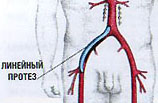The reasons for the development of congenital intestinal obstruction are associated with a violation of the intrauterine development of the child. Symptoms of the disease depends on the level of lesion localization. Treatment of congenital intestinal obstruction only surgical.
Content
Causes of congenital intestinal obstruction
 Congenital intestinal obstruction - one of the most frequent causes of urgent operations in children of newborn period.
Congenital intestinal obstruction - one of the most frequent causes of urgent operations in children of newborn period.
Reasons resulting in obstruction:
- Intrauterine defects of intestinal tube development
- violation of the intestinal rotation process
- Vices for the development of other abdominal organs
The most frequent form of malformation, which leads to congenital intestinal obstruction, is atresia and stenosis, the occurrence of which is associated with defects for the formation of an intestinal tube lumen and a violation of the blood supply of individual sections of the intestine during pregnancy. There are 3 types of atresia: in the form of a fibrous cord, a connecting shape (if there is a hole in the membrane, they talk about the stenosis) and complete with the separation of the blind ends.
More often atresia and stenosis (narrowing of the intestinal lumen) are localized in the duodenum, the initial separation department, the iliac intestine, sometimes there are multiple atresia. Less likely the reason for obstruction is the doubling of the intestine (duplicatura, enterogenic cysts), while obstruction has more often. The same group includes violations of the bookmark of nerve plexuses in the intestine wall, which leads to a change in the peristalticity of the affected department and the difficulty of the passage of intestinal content.
Basic symptoms of the disease
Congenital intestinal obstruction shared:
- Depending on the level of localization and obstacles - on high and low
- on the degree of narrowing about the guts - on full and partial
- on the occurrence - on intrauterine and postnatal (within 14 days after birth)
High obstruction in newborns occurs during the atresia of the duodenum or its stenosis. High intestinal obstruction is manifested from the first hours or days of life. Its main symptom - stubborn vomiting congestive gastric content with admixture of bile. Children quickly lose weight of the body, increasing disorders of the water and electrolyte balance and acid-alkaline system, Oliguria occurs (the amount of urine released) is sharply reduced).
When examining the stomach looks splash, against the background of which, after feeding, clearly seen the appearance of the epigastric (supever) region. During the probation of the stomach, congestive contents are obtained in an amount exceeding the norm, as a rule, with pathological impurities (bile, intestinal content). However, at the arrangement of the obstacle above the level of the duodenum, vomit mass does not contain pathological impurities.
Low intestinal obstruction can be caused by atresia and stenosis of the skinny, iliac and rising intestine, doubling the intestine. Low intestinal obstruction is also manifested from the first hours or days of life and is characterized by a significant bloating.
Characteristic enhanced, visible peristalsis of extended intestinal loops. Vomiting is less frequent than at high obstruction, however, the vomits always have a stagnant, character, unpleasant smell, contain a significant admixture of bile and intestinal contents (the so-called calla vomiting). With complete obstruction of the intestine, it is also characteristic of the lack of mecking after birth.
The symptoms of the peritonean irritation (testifying to the inflammatory process) are discovered, as a rule, in the case of late diagnosis of the strangeness of obstruction or purification of the intestine, when peritonitis develops.
Diagnosis of congenital intestinal obstruction
In suspected congenital intestinal obstruction, the examination of the patient is carried out according to the following scheme:
- Anamnese evaluation (characterized by adverse course of pregnancy, multi-way)
- Assessment of the general condition of the child (the identification of intoxication, dehydration, body weight deficit is more physiological loss, high numbers of hemoglobin and hematocrit, disorders of the acid-alkaline state)
- inspection and palpation of belly
- Protecting the stomach with assessment of the number and quality of content
- Rectal study (during atresia Mekonia is absent)
Treatment of intestinal obstruction
In confirming the diagnosis of congenital obstruction of the intestine, the child must be urgently translated into a specialized surgical hospital, where to clarify the level of obstacles, as a rule, a x-ray study is carried out. When performing radiographs, pay attention to the degree of filling in the intestine of the gas, the number of fluid levels in the extended digestive tract departments. With high impassability of their two - in the stomach and duodenalist, at low - multiple levels and gas bubbles. In the width of the liquid level, one can judge the variation of the development. With atresia, the level of fluid in the stomach is equal to or exceeds the diameter of the stomach. With an incomplete turn of the intestine, the dimensions of the duodenal intestine are normal, a scarce filling of intestinal loops is marked with gas. If a review x-ray study does not provide sufficient information, a contrast study of the gastrointestinal tract is used. The aqueous suspension of barium sulfate in the amount of disposable feeding is injected in breast milk.
For high intestinal obstruction, a violation of the evacuation function of the duodenum is characterized, so two depots of the contrast agent are visible on the radiograph - in the expanded stomach and duodenum. In case of suspicion of the incomplete turn of the intestine, the study complement the irrigography with air or barial slightening. The incorrect position of the blind intestine in the epigastric (supever) area or high under the liver confirms the diagnosis. With low intestinal obstruction, the contrast study allows you to clarify the degree of expansion of the intestinal lubers, localization of fluid levels in them, the nature of the intestinal passage disorders.
Treatment of congenital intestinal obstruction only operational. It is carried out after assessing the risk of anesthesia and operations, pre-preoperative preparation, aimed at the correction of violations of homeostasis and the functions of vital organs. The nature of operational intervention depends on the definition of development, two-stage operations are possible with low forms of intestinal obstruction, while the first stage is to impose intestinal fistula.
Forecast with a timely manner performed by the operational intervention and the absence of other malformations favorable.









